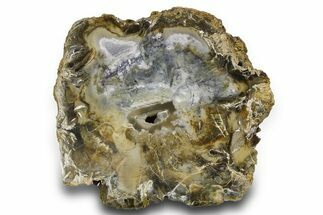This Specimen has been sold.
10.8" Tropical Hardwood Petrified Wood Dish - Indonesia
This is a beautiful 20 million year old petrified hard wood specimen from Indonesia that has been polished into a plate/dish. The petrified wood dish is approximately 10.8 inches wide. You can clearly see the tree rings and inner structure of the wood.
This petrified wood dish is likely not dishwasher safe and would make a better display piece as opposed to a plate for food consumption.
This petrified wood dish is likely not dishwasher safe and would make a better display piece as opposed to a plate for food consumption.
What Is Petrified Wood
Petrified wood is the name given to wood that has been turned into stone (fossilized) through the process of permineralization. In this process, all of the organic matter becomes replaced by minerals, while much of the original structure, such as tree rings, is retained. For this to happen, the wood needs to be buried in an environment low in oxygen to prevent decomposition and with flowing, mineral-laden water, so minerals may replace structures. The coloration is caused by various minerals that present in that water during fossilization. For example, red colors are due to iron compounds, greens due to copper, and so on.
Petrified wood is the name given to wood that has been turned into stone (fossilized) through the process of permineralization. In this process, all of the organic matter becomes replaced by minerals, while much of the original structure, such as tree rings, is retained. For this to happen, the wood needs to be buried in an environment low in oxygen to prevent decomposition and with flowing, mineral-laden water, so minerals may replace structures. The coloration is caused by various minerals that present in that water during fossilization. For example, red colors are due to iron compounds, greens due to copper, and so on.
SPECIES
Tropical Hardwood
LOCATION
Indonesia
FORMATION
Genteng Formation
SIZE
10.8 x 9.6 x .8"
CATEGORY
SUB CATEGORY
ITEM
#210577
We guarantee the authenticity of all of our specimens.
 Reviews
Reviews












